The rich and varied cultural offerings of India are beautifully reflected in this sensory adventure in the Golden Triangle. This tour provides a memorable showcase of how community and culture have played a pivotal role in fabricating a tapestry of multi-layered textures of its history and heritage.
Monumental Treasures
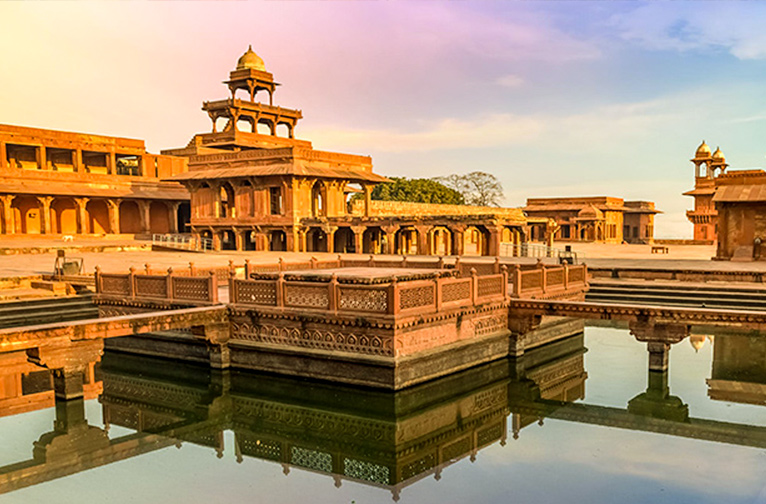
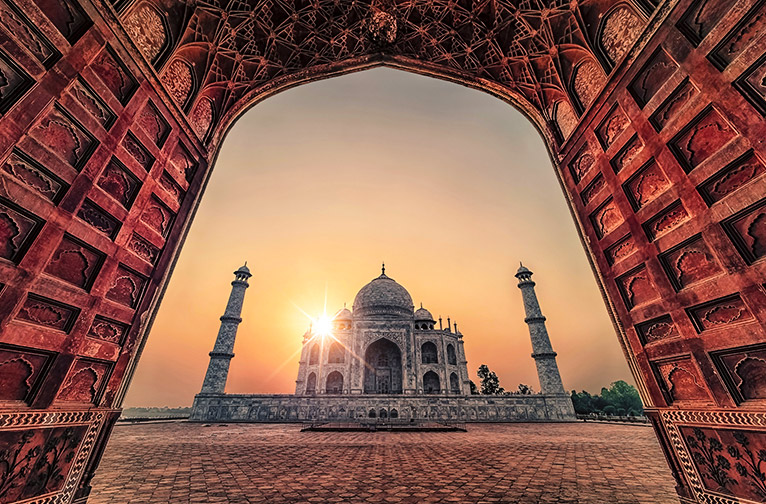
From the pristine white marble of the Taj Mahal and itimad-ud-daulah's tomb in Sikandra to the glories of red sandstone in Akbar’s ghostly bastion of Fatehpur Sikiri, Delhi’s Red Fort and the stunning Mughal buildings in the Mehrauli Archaeological Park and the Hawa Mahal and other buildings in the bazaar in Jaipur, the visitors cannot but marvel at the amazing feats of architecture rendered in this exotic material in the Golden Triangle. Jaipur, long renowned for its exquisite stonecraft, was a leading source of marble and high-quality stone quarried in Makrana, Dholpur, Dungarpur, Sikandra and Dausa. The use of limestone in constructions paved the way for a diverse range of exquisite renditions in lime crafts in Jaipur include moulding, plasterwork and other traditional decorative architectural features such as carved stone screens or jalis (lattice work), railings and parapet detailing. High quality sandstone too was found in abundance in Rajasthan and was highly favoured for its versatility as a building material. You can see in the gorgeous jali work in the Hawa Mahal as well as various other structures, such as the elegant palaces and mansions of the nobility. At the Taj Mahal and Itimad-ud-daulah's tomb you will be blown away by the elaborate usage of pietra dura, the inlay of semi-precious stones in white marble
Textile Tales
The diverse and incredibly rich portfolio of India’s textile traditions is amply represented by the pickings you will discover on a shopping spree along the Golden Triangle. Cotton and silk are the raw materials that have traditionally been intrinsically linked to Indian textiles, as has its own handweaving tradition. From the stunning silks from Kanchipuram, Mysore the southern states, the splendorous brocade work from Banaras/Varanasi, hand-woven cottons and block-printed fabrics from Gujarat, Andhra, ikats from Assam, kantha sarees from Bengal…they have all found their way to the bazaars here to showcase these centuries old traditions stemming from humble craft-centric villages scattered across the country. Woven into the cultural fabric of India these shining traditions have illuminated its presence on the world stage.
In Delhi, the Old City markets are still a favoured spot for buying these wondrous sarees and textiles for everyday wear and bridal trousseaus at more decent rates than you would get in the swanky malls and bespoke boutiques around town. For traditional handmade sarees from the different regions the state emporia, in Connaught Place, are an excellent source as is the wondrous Cottage Emporium on Janpath. Dilli Haat is another good option; it’s a great place to take a pause and sample the offerings of regional specialities from the line-up of food stalls here. Lajpat Nagar and Karol Bagh are the most popular spots for locals and tourists for bargain-hunting and indulgences in more exotic fabrics and sarees.
Agra, the old Mughal bastion, has been famed for its gorgeous zardozi (brocade) embroidery work, propelled by the demand accruing from the emperor’s household and the nobility of the court. The tradition of zardozi was introduced by the Turko-Afghan Sultans of the Delhi Sultanate. For the delicate Chikankari work of Lucknow and the silks from Varanasi, the best place for these indulgences are the shops scattered around the Taj Mahal, in Sadar Bazaar, Kinari Bazaar and Munro Road. The city is also a past master at mirror work. While you are in Agra you should definitely check out the handwoven rugs and carpets for which the city has long built up its reputation as a manufacturing centre. Pay a visit to UP Handlooms and UPICA, a one-stop-shop for traditional textiles and handicrafts, on MG Road.
The state of Rajasthan has a long and vivid history of textile traditions and Jaipur’s multiple bazaars are perfect for sourcing these. The villages of Sanganer and Bagru near the city have made their names globally for the legacies of their incredible block printing skills. On your visits here you can observe the Chhipa community master craftsmen at work. Alternatively, a trip to the Anokhi Museum of Hand Printing, located in the shadow of the Amer Fort, offers an insightful experience of these textile traditions. The Sankalan embroidery design and production house in Jaipur, is famed for the exquisite stitching techniques it keeps alive. The Rajasthan Khadi Sangh, a weaving cooperative in Kala Dera, Rajasthan uses traditional tools and equipment to weave cotton Khadi cloth Khadi cloth, adopted by Indian freedom fighters as a symbol of resistance against British rule.
Spice Box
In Delhi you will have a truly unique experience immersing yourself in the fantastic sensory feast of Asia’s largest wholesale trade spice market since the 17th century— Khari Baoli in the Shahjehanabad of yesteryears. It was strategically positioned along important trade routes passing through the city. The market was believed to have been commissioned by one of Emperor Shahjehan’s wives. Did you know that till the early 1800s the area between the Red Fort and the Bara Hindu Rao Hospital up on the northern ridge was still called Shahjehnabad. Now we just call it Chandni Chowk which kind of seems to encompass many parts of the sheher or Old Quarter in the city.
Located near the historic Fatehpuri Masjid in Old Delhi, the market is an energetic, magical world of colours, aromas and textures largely dedicated to the culinary arts. With racks and gunny bags spilling over with fresh spices (both in whole and powdered form), dry fruit, nuts, pickles and chutneys, cooling sherberts fragrant with essence of rose, kewra, khus and sandalwood, candied fruit, mouth fresheners, herbs, loose tea and tobacco, grains, varieties of rice, pulses and lentils, it’s a mesmerising experience as you mingle with the jostling crowd, ambling along from one shop to the next soaking in the charms of this aromatic world; some of these shops go back at least 10 or even 12 generations.—The wholesale section is located in the 3-storied the Gadodia Market in the heart of the bazaar.
In Agra the Rawatpara market, near the Jama Masjid, is an alluring world of aromatic wares. You’ll find masses of traditional native spices in a vibrant display of colours and textures from across the Indian sub-continent, but also edging in to gain a foothold are international newcomers like pastas and pestos— and the like, to cater to the city’s evolving taste buds. It’s a great place to pick up the city’s iconic petha, a sweet made from gourd.
Coriander, cumin, fennel, fenugreek, and ajwain are widely grown in Rajasthan, and Jaipur’s oldest and biggest spice market, a lazy sprawl between the Bapu Bazaar and Tripolia Bazaar, offers you several variants from its different regions. Cumin is the crown jewel of Rajasthan’s storyboard. Districts like Jalore and Barmer are established global suppliers. While chilies too are a favoured buy, what you should definitely pick up are the potent Mathania chillies; infused with heat, flavour and colour these are grown and processed in the village of the same name, close to the desert city of Jodhpur. They are an intrinsic component in Rajasthani dishes like laal maas.
Culinary Capers
Your travels in the Golden Triangle are boosted by some of the most fun-filled culinary adventures that are intrinsically linked to the local community culture in these regions. While Delhi is unsurpassed by the grand canvass of national and international culinary offerings, an unmissable part of your engagement with it is a food tour in the Walled City. A guided tour of Old Delhi is ideal for a leisurely jaunt sampling centuries-old street food traditions which are driven by a seamless blend of its mixed community cultural traditions and culinary heritage.
Sip and sup your way around Agra’s expanding restaurant, café and street food landscape, for a thoroughly enjoyable sensory experience. With its ideal location by the Yamuna River cutting through the Northern Plain, it has long been a vibrant cross-cultural hub. The fusion of its Mughal and Braj region food traditions which have seamlessly blended with the culinary heritage of Uttar Pradesh state, offer the foodie an exciting experience to look forward to.
Jaipur city’s foodie landscape provides the perfect showcase of Rajasthani food and culture. The ingenuity and innovative skills embedded in its culinary offerings are beautifully aligned to the survival needs in the hot and arid expanses of this desert state. The twin components, of the minimalist but tasty dishes from the rural kitchen and the exotic preparations created in the palaces, offer an exceptional study in contrasts of how the people here have adapted to their environs different parts of Rajasthan while using the same ingredients and spices. The Rajputs, the Vaishnavs, the Marwaris, the Bishnois and many other communities provide this culinary heritage with time-worn traditions which enrich a palate-stirring adventure around the state. From veggie offerings to exotic meat dishes, from chutneys to deserts, the repertoire of flavours and textures of Rajasthani cuisine is a significant window to its cultural richness.
Floral Fantasies
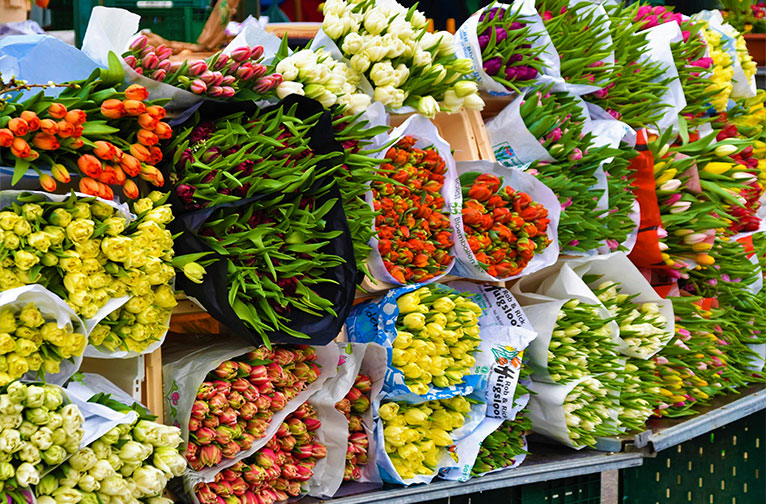
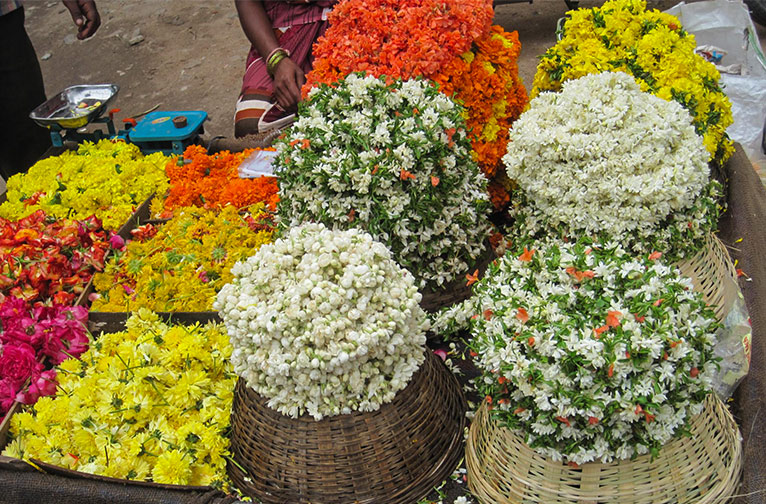
Wend your way through the flower mandis, or whole sale markets in Delhi-Jaipur and Agra and let all your senses swoon over the plenitude of scents and colours, shapes and sizes and variety of textures of the exotic blooms you’ll find. You’ll discover too the infinite variety of some of the choicest flowers and foliage drawn from various regions of the country in some of the better equipped flower bazaars—jasmine from Madurai, roses and marigold from Kannauj, gorgeous greens from Bangalore ‘the garden city’, heaps of lotus flower plucked early from their watery beds, pearled still with the morning dew, dashing sunflowers, elegant gladioli and so much more. What may come as a surprise to you when you might even come upon the displays of exotic lilies, tulips, orchids and anthuriums by a vendor looking for a more upscale clientele to pick up his wares. There are flowers and foliage available for multiple needs----garlands of marigold, roses and jasmine for offerings in the temples, leaves of the Ashoka tree for worship rituals, Tesu flowers for Holi, cut flowers for home décor and hotels, bouquets and wreath material for the city’s retail flower shops…now popping up even in neighbourhood markets. Heaps of rose petals, tiny garlands of jasmine to adorn a woman’s hair or to tie on your wrist to and clusters of leaves traditionally used for worship in Hindu temples. The big lure is being able to pick these up at a considerably lower price than at the retail outlets. You’ll even find artisans, despite the hustle and bustle around them, calmly sitting around making garlands from marigold and roses. Mingle with the early buyers looking to get the best bargains and best blooms from the vendors guarding their produce with care and cunning to strike the best deals. Be it a wedding, a religious ceremony, a festival or a state visit by a foreign guest of the government, the flower mandi has a host of gorgeous blooms to cater to their specific needs.
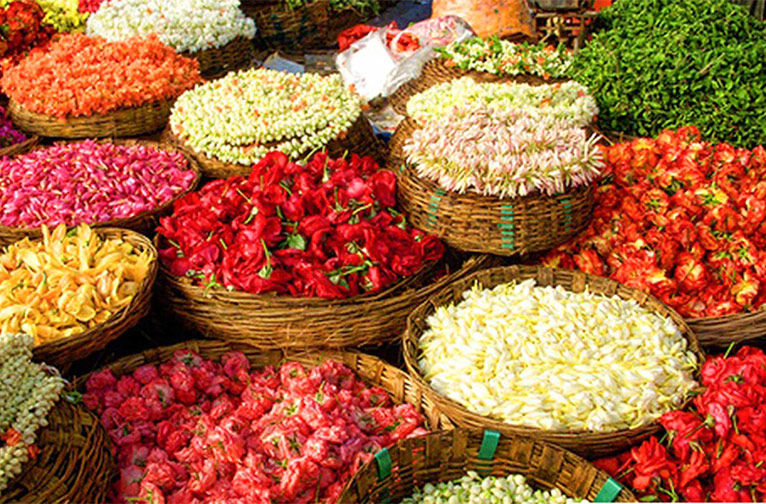
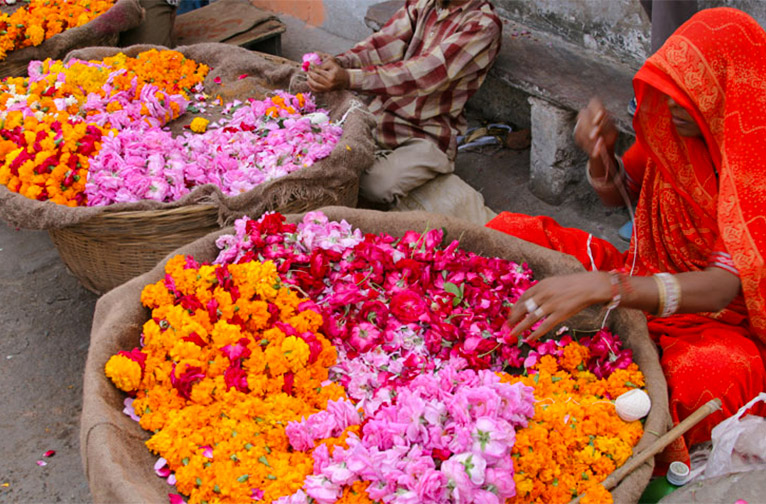
Delhi's largest flower market, the Ghazipur flower market, pulls in traders and retailers and the odd housewife. The atmospheric Fatehpuri Flower Market, dating back to the Mughal times in the Old Quarter in Delhi with its piles and sacks of loose marigolds and garlands in various hues of the sunset.is wonderful to experience. By 9am business is done and the Khari Baoli Spice Market opens up a couple of hours later with its exotic offerings from all over Asia. The flower market at Baba Kharak Singh Marg, opposite Hanuman Mandir is worth exploring. The emporiums are still closed here as the market operates only between 4 am to 9 am. The Chattarpur Phool Mandi on 100 Feet Rd, Dr Ambedkar Colony offers both native flowers and blooms from around the world. The Mehrauli Phool Mandi at Andheria Modh, open all day, is a good choice if you plan to visit the Qutub Complex and Mehrauli Archaeological Park in the early part of the morning. Did you know that Delhi traditionally hosts the Phoolwalon ki Sair in Mehrauli each year. This festival of flower sellers involves weeklong festivities at Qutb Sahib’s Dargah and the Yogmaya Temple, with kite flying, Sufi qawwalis and Indian-style wrestling matches.
An Agra the biggest Flower market I is located in Baluganj, and does brisk business from 6 to 9 a.m. In Jaipur the Phool Mandi has been relocated to Kanwar Nagar a short distance from the Hawa Mahal. The trade of both marigold and local rose variants is brisk and offers visitors an immersive insight into the commercial vibrancy of the flower business. These blooms are sourced from places like Jamwa Ramgarh, Chomu, Kanota etc. the market also thrives on sales of imported varieties such as orchids, carnations and English roses, drawn from farmers in Himachal and Karnataka.
This incredible adventure offers many opportunities to explore the cultural richness through the senses as you encounter stone-crafted forts and marble tombs and shrines, silken sarees and block prints in bazaars, the pungent aromas of spices, the splendour of flowers and foliage, the culinary heritage of communities and so much more.